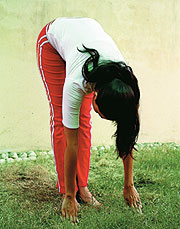 Nowadays people seem happy to go under the doctorís knife to get rid of their bulging stomachs. But this is very unnatural and is not a long-term solution, plus it may have many side effects. I have received many queries on asans for fat reduction, so first I will explain fat management from the yogic point of view. I want to make it clear to the reader that people of kapha type easily put on weight on the body, and this weight is visible (on face and stomach area) and hence is easy to remove. Nowadays people seem happy to go under the doctorís knife to get rid of their bulging stomachs. But this is very unnatural and is not a long-term solution, plus it may have many side effects. I have received many queries on asans for fat reduction, so first I will explain fat management from the yogic point of view. I want to make it clear to the reader that people of kapha type easily put on weight on the body, and this weight is visible (on face and stomach area) and hence is easy to remove.
The other two types i.e. the vata and pitta types also put on weight, but this weight is of a different kind, which is much more dangerous than fat. This excess weight manifests in the physical body as depression with symptoms of a bad stomach, insomnia, self-pity, and suicidal tendency. These symptoms cause heaviness in the body. Resorting to various kinds of diet programmes or doing asanas in isolation have little effect nor does having some herbs have any major effect on these types.
Two of the very important purifications in Ashtang yoga in general, and the Sanatan Kriya in particular, are non-collection and purity of thought. As the body is an inherent part of the universe and brahmand, so it is also governed by the laws of nature, one of which is non-collection. If we observe nature, wherever there is collection, be it any kind, an imbalance is going to develop. Be it emotional (congested emotions) or physical (obesity).
You can practice the asans that I will be giving here. In yoga a lot of emphasis is put on breath, and asans are always performed in synchronisation with the breath. It is very important to know the correct way of breathing. Breathing in ujjai increases the efficacy of an asan, so Iím explaining ujjai breath first.
Ujjai: slowly start inhaling, and though you breathe in from the nose only, keeping the mouth shut, you put a little pressure on the throat, so there is a hissing sound when the breath passes through the throat, as in snoring, but a soft gentle sound, the abdominal area (not the chest) expands as you breathe in. Similarly exhale, making a hissing sound, the abdomen contracts when you exhale. The pace is slow and exhalation is longer than inhalation. Initially no count is kept, breathe at a pace you are absolutely comfortable at.
Padhasta Asana: Stand straight, breathing in ujjai, inhale, start bending forward, Then come down slowly and gently, place your palms flat on the ground. Hold the posture for seven counts breathing at normal pace in ujjai. Your back should not be making an arch or slouching forward and your knees should not be bent. This will help in eliminating and preventing abdominal ailments and reduce weight from the abdominal area, thighs and lower waist. It also tones thigh and calf muscles and also improves digestion.
With practice increase the count gradually.
Warning: this is an advanced asan and is only done when the spine has gained enough strength by initial practices prescribed in Sanatan Kriya. Those with injured spine, back pain, weak stomach, cervical spondylitis are advised not to do this asan.
|